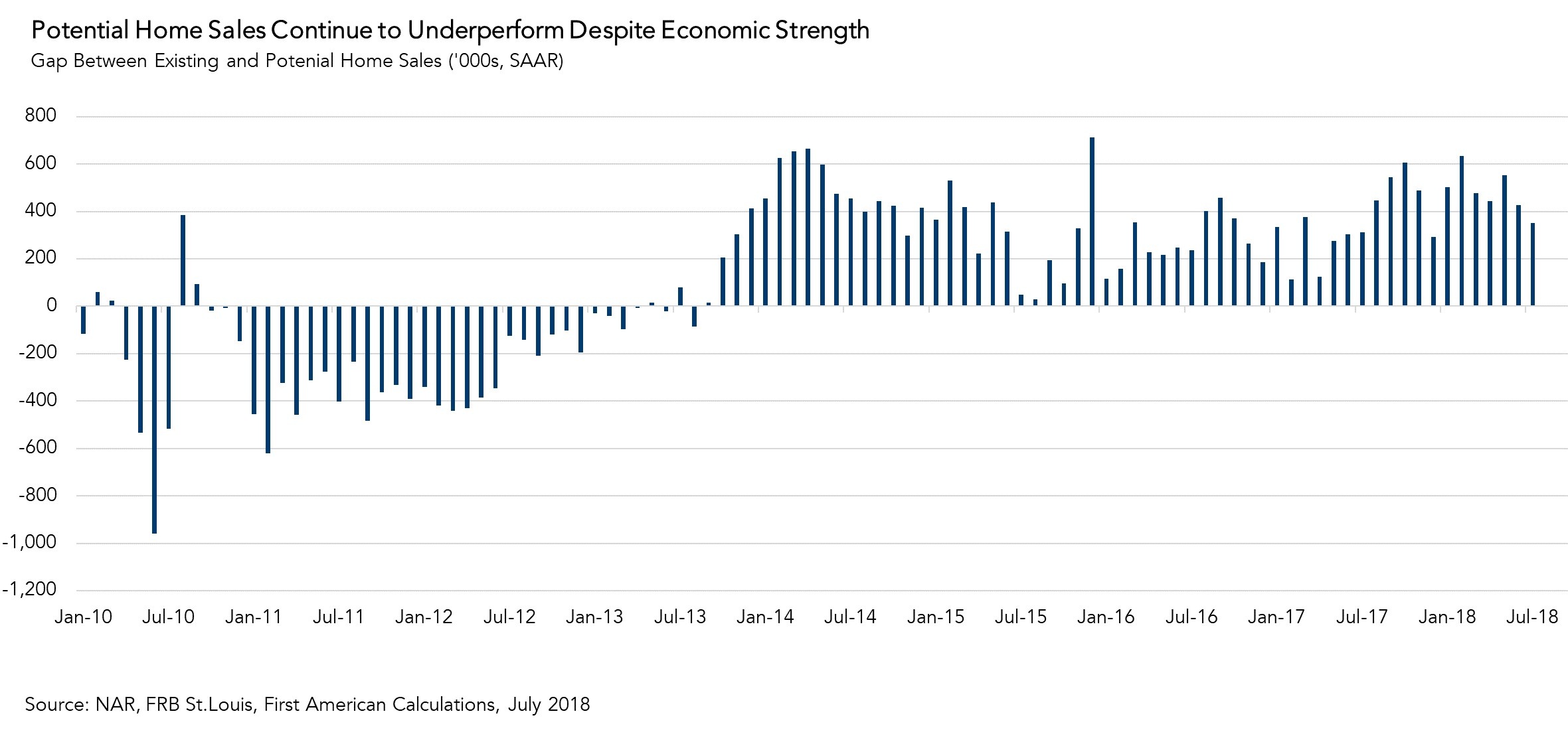The U.S. economy remains on an impressive growth streak. Last month, the Commerce Department reported that the gross domestic product, the broadest measure of goods and services produced in the economy, grew at a 4.1 percent annualized rate in the second quarter, the strongest pace of growth since 2014. The economy has added jobs every month for 94 consecutive months, producing the lowest unemployment rate since 2000.
“If existing homeowners remain hesitant to list their homes for sale, then increasing the pace of new home construction is necessary to alleviate the supply shortage that the housing market faces today.”
However, in spite of the macro-economic momentum, the housing market continued to underperform its potential in July. Actual existing-home sales are 5.8 percent below the market potential for existing-home sales, according to our Potential Home Sales model, which estimates the expected level of existing-home sales based on market fundamentals. The market for existing-home sales is underperforming its potential by an estimated 352,000 sales at a seasonally adjusted annualized rate (SAAR). Existing-home sales, which make up approximately 90 percent of U.S. home sales, continue to disappoint in 2018, despite what was likely the strongest period of economic growth since 2014.
The Economy is Hot, The Housing Market is Hot, Home Sales… Are Not
The housing market is moving at an exceptional rate these days. According to data from DataTree by First American, the median sale price of a home in the U.S. was approximately $230,000 in June – the highest since 2007. Additionally, the average home was sold in 54 days in June, a new record according to Realtor.com. Despite the terrific economic backdrop and a hot housing market, home sales remain below their market potential. Why could this be?
Our research shows that rising rates, especially when they are still historically low, don’t significantly discourage home buyers, but evidence is growing that indicates rising rates do influence the home sellers. Rising rates reduce the incentive for current homeowners to sell their homes. There are limited reasons to sell when, due to higher mortgage rates, it will cost you more each month just to borrow the same amount from the bank. Additionally, existing homeowners are hesitant to sell their homes as they are afraid that they will not be able to find a home to buy. Home sales are being stifled by a shortage of homes on the market. The game of musical chairs that is the housing market today needs more chairs.
The Answer? Build, Build, Build
Homebuilding, as a source of new supply, is crucial to solving the housing supply shortage. Homebuilders don’t have existing mortgages or the fear of not being able to find something to buy. Additional supply, particularly of new entry-level homes to meet the needs of the first-time buyers who remain interested in buying even as rates increase, is critical to satisfy the rising demand for housing. If existing homeowners remain hesitant to list their homes for sale, then increasing the pace of new home construction is necessary to alleviate the supply shortage that the housing market faces today.

July 2018 Potential Home Sales
For the month of July, First American updated its proprietary Potential Home Sales model to show that:
- Potential existing-home sales increased to a 6.08 million seasonally adjusted annualized rate (SAAR), a 0.3 percent month-over-month increase.
- This represents a 62.8 percent increase from the market potential low point reached in February 2011.
- The market potential for existing-home sales increased by 3.5 percent compared with a year ago, a gain of 208,900 (SAAR) sales.
- Currently, potential existing-home sales is 1.21 million (SAAR), or 16.6 percent below the pre-recession peak of market potential, which occurred in July 2005.
Market Performance Gap
- The market for existing-home sales is underperforming its potential by 5.8 percent or an estimated 352,000 (SAAR) sales.
- The market performance gap decreased by an estimated 75,000 (SAAR) sales between June 2018 and July 2018.
What Insight Does the Potential Home Sales Model Reveal?
When considering the right time to buy or sell a home, an important factor in the decision should be the market’s overall health, which is largely a function of supply and demand. Knowing how close the market is to a healthy level of activity can help consumers determine if it is a good time to buy or sell, and what might happen to the market in the future. That is difficult to assess when looking at the number of homes sold at a particular point in time without understanding the health of the market at that time. Historical context is critically important. Our potential home sales model measures what we believe a healthy market level of home sales should be based on the economic, demographic and housing market environments.
About the Potential Home Sales Model
Potential home sales measures existing-homes sales, which include single-family homes, townhomes, condominiums and co-ops on a seasonally adjusted annualized rate based on the historical relationship between existing-home sales and U.S. population demographic data, income and labor market conditions in the U.S. economy, price trends in the U.S. housing market, and conditions in the financial market. When the actual level of existing-home sales are significantly above potential home sales, the pace of turnover is not supported by market fundamentals and there is an increased likelihood of a market correction. Conversely, seasonally adjusted, annualized rates of actual existing-home sales below the level of potential existing-home sales indicate market turnover is underperforming the rate fundamentally supported by the current conditions. Actual seasonally adjusted annualized existing-home sales may exceed or fall short of the potential rate of sales for a variety of reasons, including non-traditional market conditions, policy constraints and market participant behavior. Recent potential home sale estimates are subject to revision in order to reflect the most up-to-date information available on the economy, housing market and financial conditions. The Potential Home Sales model is published prior to the National Association of Realtors’ Existing-Home Sales report each month.



